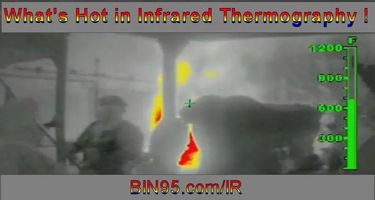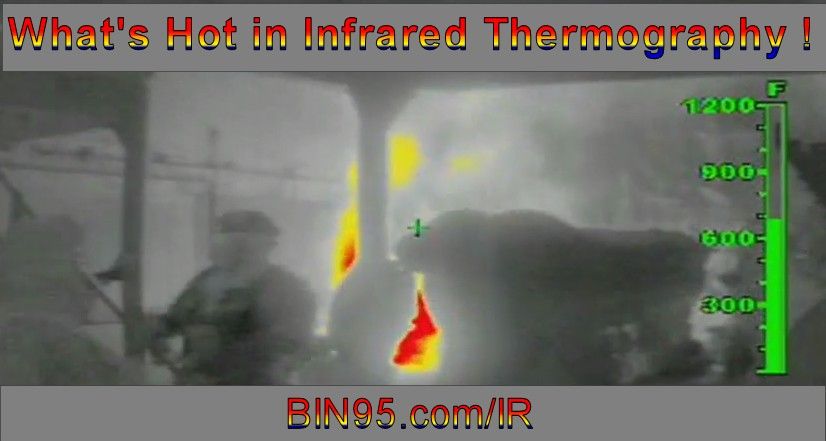What is Thermography!
- Home >
- articles >
- electrical >
- what is infrared thermography
What is Infrared Thermography Inspection.
Thermographic inspections have been used for over thirty years as components in both preventive and predictive maintenance programs. In the hands of a trained and experienced operator, a thermal imager can provide a wealth of information that can improve efficiency, productivity, and safety. With interest in thermography at an all-time high and equipment costs at record low prices, there has never been a better time to capitalize on the benefits of an infrared inspection program. In this series of videos, we will explore some of the more common infrared thermography applications of commercial and industrial thermography. The fist video "What is Thermography (Thermal Imaging)" is below.

What is Thermography?
Infrared thermography is the use of an infrared thermal imaging system to detect, display, and record thermal patterns and temperature values across a given surface. The concept of infrared thermography is simple (how does thermal imaging work). All objects above absolute zero,or zero Kelvin,emit infrared radiation. While infrared energy is invisible to the human eye, it is detectable with a thermal imager, also known as an infrared camera. Infrared data obtained can be observed in real-time or captured to videotape, PC card, or electronic media for post-analysis. Today's modern thermal imagers are video camera- like devices, which often can fit in the palm of your hand. A thermal imager converts the invisible infrared imaging into a monochrome or multicolored image, which represents the apparent thermal patterns across the surface of the object being inspected. When recorded on photographic film or paper, these images are referred to as thermograms. Many modern imagers are also capable of recording temperature, as well. Once captured, thermal images and associated temperatures can be stored for future reference and analysis. Infrared thermography is both noncontact and nondestructive. Infrared inspections require no interruption of service. Additionally, thermal imagers emit no harmful radiation and are completely passive.
Why Thermography?
As we move further into the 21st century, companies will continue to face the demands associated with a global economy. These demands include increased competition, both domestically and abroad. As the world becomes smaller, the number of competitors expands. No longer will it be enough to be the most competitive in the nation. Companies must strive to be the best in the world. In a global economy, companies must turn out the highest quality products in an efficient manner, with less manpower, while remaining profitable. Oftentimes, this requirement is coupled with the prospect of performing more maintenance tasks with fewer people. With these demands in mind, many companies are utilizing predictive maintenance technologies to help meet their objectives. While infrared thermography is one of the newest nondestructive technologies, it can help to provide substantial improvements in performance, as well as tremendous cost savings. Other proven technologies include vibration analysis, oil analysis, and ultrasound, to name a few.

Uses of Infrared Thermography
There are many uses for infrared thermography. These include, but are not limited to, preventive maintenance, predictive maintenance, condition monitoring, forensic investigations, research and development, and quality assurance. In short, thermography may be applied to any situation where knowledge of thermal patterns across a given surface can provide meaningful data about a structure, process, object, or system. Infrared Thermography is a growing field where new applications are being developed. The use of thermography is often limited only by one's imagination.
Common Industrial Thermography Applications
As stated previously, thermography can be applied to a wide range of systems, objects, and structures. Common industrial applications include electrical distribution systems, to locate loose or deteriorating connections, overloads, imbalanced loads, open circuits, defective equipment, and symptoms of harmonics; mechanical systems, to detect excessive friction, misalignment, improper lubrication, and belt tension; structural systems, to locate water infiltration into building side-walls and flat roof systems, detect building energy loss, and locate the delaminations or voids in masonry structures; petrochemical refineries, to identify missing or damaged refractory within boilers, furnaces, and kilns, and to monitor process equipment for proper operation; research and development, for numerous applications, including thermal profiling for printed circuit boards and components, as well as evaluating the thermal performance of a variety of industrial and consumer items.
Individuals open more doors! Businesses, gain new revenue streams!
At the Online Infrared Training Center, you can learn about the numerous applications of infrared thermography. Full ranges of training courses provided so you can become a Certified Infrared Thermographer© or earn a specialized certificate in your desired field or application, or both! Of course, as seen from the above many infrared applications, you can also profit from running your own infrared inspection business or adding infrared inspection services to your existing business offering to increase your company's revenue stream.
Please use the comment area below for questions and comments about this article or the online thermography training we offer.
IR on IR (Interact Real-time on Infrared Discussions below)
Next Article ...
Infrared Thermography applications and uses of thermography
Business Article - Equipment failure and the cost of failure
True Downtime Cost - downtime tracking, OEE, root cause
Another way for electrical Contractors and OEMs to expand their business
